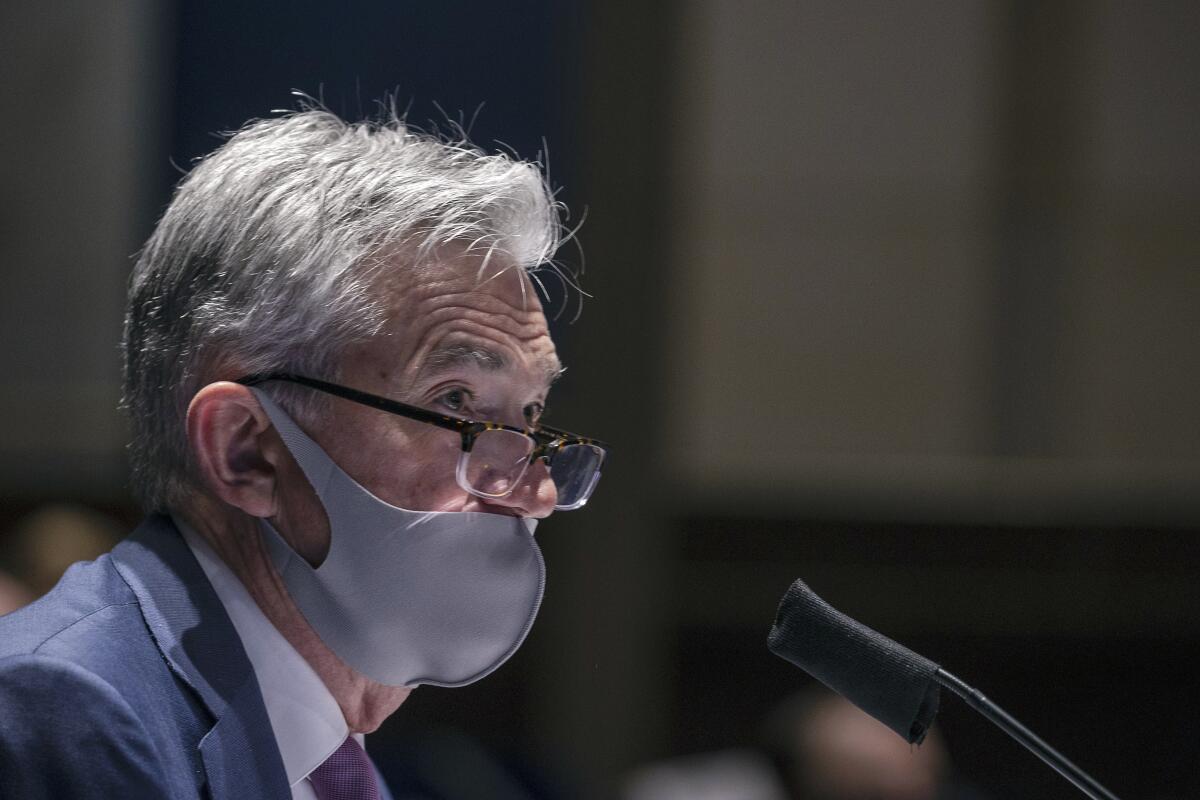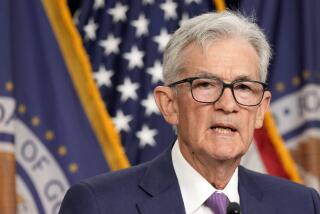Fed expected to keep interest rates near zero through 2023

- Share via
WASHINGTON — The Federal Reserve is likely to keep interest rates pinned near zero at least through 2023, according to projections released Wednesday that also show Fed officials are more upbeat about the near-term prospects for the pandemic-battered U.S. economy.
The central bank also began to put into effect its recently announced policy framework that will essentially maintain low interest rates longer.
In its statement Wednesday after a two-day meeting, the Fed said that it would aim to push inflation moderately above its long-held 2% target — once largely viewed as a ceiling — and that it won’t raise interest rates until this and other related goals are achieved. Analysts said that means it could be five years or longer before the Fed raises rates.
“If you take the forecast on its face, yeah, this is years and years,” said Diane Swonk, chief economist at the accounting and consulting firm Grant Thornton in Chicago.
The Fed’s brighter economic outlook reflects the stronger-than-expected recovery in the labor market and other sectors of the economy since more businesses reopened this summer, however halting and uneven that has been.
More recently, however, data on job postings, small-business revenues and consumer spending suggest that the economy has been moving sideways, if not backsliding a bit, according to Opportunity Insights, a nonpartisan group based at Harvard University that is tracking the economic effects of the pandemic.
In June, Fed officials forecast the unemployment rate at 9.3% in the fourth quarter, but government officials reported the jobless figure dropped to 8.4% in August from a high of 14.7% in April.
The new projections show that officials, on average, are now looking for unemployment to end the year at 7.6% and to decline to 4.6% by end of 2022, compared with 5.5% in Fed policymakers’ forecast three months ago.
Before the pandemic hit, the jobless rate had fallen to 3.5%, a 50-year low that opened more doors especially for less-educated and other disadvantaged workers. And Fed Chairman Jerome H. Powell, in a news conference Wednesday, said he would “love to get back to that,” noting that with unemployment at that level, gains “being shared vary widely across the income spectrum. In fact more to people at the bottom end of the spectrum.”
But most Fed officials don’t see unemployment returning to pre-pandemic levels until after 2023 — and that’s another reason rates are likely to stay at rock bottom for years to come, said Chris Rupkey, chief financial economist at MUFG Bank in New York.
“This argues for interest rates staying lower for longer to make sure the economic expansion is durable and lasting and that all those who lost their jobs this year are able to rejoin the workforce,” he said.
The government’s August jobs report said that the economy has recovered about half of the 22 million payroll jobs lost in March and April, but separate data also show that some 30 million people claimed unemployment benefits in August.
Fed policymakers also painted a more sanguine picture of economic growth. Three months ago, Fed officials on average saw gross domestic product, the sum of goods and services produced in the nation, falling 6.5% this year and then growing 5% in 2021. They now see GDP contracting 3.7% this year and expanding 4% in 2021.
Still, Powell acknowledged that the outlook remains highly uncertain and hinges on the path of the pandemic. What’s more, he said that Fed officials made their projections based on the assumption that there will be additional fiscal support, which is not at all clear will be forthcoming.
“The fiscal policy actions that have been taken thus far have made a critical difference to families, businesses and communities across the country,” he said. “Even so, the current economic downturn is the most severe in our lifetimes. It will take awhile to get back to the levels of economic activity and employment that prevailed at the beginning of this year, and it may take continued support from both monetary and fiscal policy to achieve that.”
The Fed has moved aggressively to support the recovery, and its new policy approach — although in the works well before the coronavirus outbreak — could have significant long-term effects, including risks of increasing speculation and asset bubbles.
The shift in strategy, which Powell announced Aug. 27, means the Fed will focus more on expanding employment and worry less about meeting its 2% inflation target. Inflation has been running well below that target for years, and under the new approach, the Fed would shoot for an average 2% inflation rate, giving it more flexibility to allow inflation to rise above that level for some time before moving to raise interest rates to avert a potential overheating in the economy.
In its statement Wednesday, the Fed said it “will aim to achieve inflation moderately above 2% for some time so that inflation averages 2% over time and longer-term inflation expectations remain well anchored at 2%.” And until those goals are achieved, it said, the Fed would maintain its current easy-money policies.
Powell declined to say more specifically what “moderately above” means. Nor would he get pinned down on the time frame for letting inflation rise above 2%, saying only that it’s “not permanently and not for a sustained period.”
“We are resisting the urge to try to create some sort of a rule or a formula here,” he said.
The policy statement was supported by Powell and seven of his colleagues. Two voting members dissented.
In their projections Wednesday, the vast majority of Fed policymakers see rates staying near zero through 2023, which is as far as the forecast goes. In the longer run, Fed officials expect the central bank’s benchmark interest rate to rise to 2% to 3%, well below historical levels.
More to Read
Get the L.A. Times Politics newsletter
Deeply reported insights into legislation, politics and policy from Sacramento, Washington and beyond. In your inbox three times per week.
You may occasionally receive promotional content from the Los Angeles Times.











